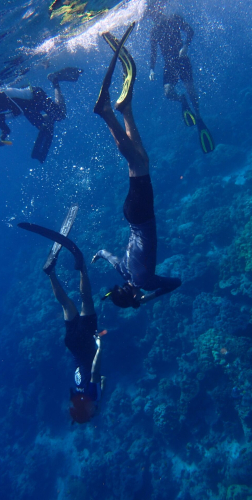Planet Bali Dive.Com | Bali, a renowned tourist hotspot, is not just famous for its beautiful beaches and rich cultural experiences, but also for its mesmerizing underwater world that attracts scuba diving enthusiasts from around the globe. With its diverse marine life and distinctive underwater scenery, Bali has become a top choice for diving aficionados. However, the ideal time for diving in Bali varies depending on factors such as weather, water temperatures, and diving conditions. In this blog, we will delve into the best months for diving in Bali, equipping you with all the necessary information to plan your next diving adventure.
Table of Contents
ToggleBest Month for Diving in Bali
Bali provides diving opportunities throughout the year, with certain months offering better experiences depending on your preferences. Here are the optimal months for diving in Bali:
Dry Season: April – October
The months of [specific months] are widely regarded as the prime time for scuba diving in Bali. The weather is typically dry, and the sea conditions are calm, creating perfect diving conditions. Visibility is exceptional, with water temperatures ranging from 27-30°C. Divers can anticipate encountering a diverse array of marine life, such as manta rays, turtles, and vibrant tropical fish during this period. It’s worth noting that this time of year is also the peak tourist season in Bali, so it’s advisable to book your diving excursions well in advance.
Rainy Season: November – March
Bali experiences its rainy season during these months, bringing occasional downpours and high humidity levels. Despite the weather, diving is still feasible with water temperatures ranging from 26-29°C. While visibility may not be as pristine as during the dry season, divers can anticipate encountering a diverse array of marine life, such as frogfish, seahorses, and nudibranchs. Diving conditions during this season can be unpredictable, with occasional strong currents and rough sea conditions.
When selecting the optimal month, there are several factors to take into account.
Before you embark on your diving adventure in Bali, it’s crucial to consider several important factors that will enhance your experience. We’ll explore the weather conditions, water clarity, marine life sightings, and tourist crowds to help you choose the optimal time for your diving excursion.
Weather Conditions
If you’ve ever attempted to relax on the beach during a stormy day, you understand the significant impact that weather can have on outdoor activities. When it comes to diving in Bali, the weather is a crucial factor. Picture yourself effortlessly gliding through the water under a clear, sunny sky, as opposed to battling rough waves in a heavy downpour – the difference is like night and day! Bali’s dry season, from April to October, typically offers sunny and tranquil conditions that can elevate a good dive into an unforgettable experience.
Water Visibility
Picture yourself in a dimly lit movie theater, squinting to make out the details on the screen. That’s akin to diving in murky water— you’re unable to fully appreciate the stunning beauty of the underwater world. On the other hand, diving in clear water is like watching a high-definition movie: the colors are vibrant, the marine life is sharp, and the entire experience is heightened. In Bali, water visibility tends to improve during the dry season, particularly in the early morning when the water is often at its clearest.
Marine Life
Diving is not just about the water and the views; it’s also a rare opportunity to interact with marine life in their natural habitat. Each month can be likened to a different episode in a nature documentary. Some months, you may find yourself as the guest of honor at a manta ray parade, while other times you might be in the domain of sharks. Researching the seasonality of marine life in Bali can add an extra layer of excitement to your diving plans. For example, the period from April to November is often referred to as ‘Manta Ray Season,’ while January to March is a great time to encounter sharks.
Tourist Crowds
Numerous individuals seek to experience the tranquility of diving without the presence of large crowds. Visiting popular diving spots during peak seasons, such as Bali’s bustling months, may result in overcrowding and a lack of serenity. For a more peaceful and enjoyable underwater experience, consider scheduling your dive during less busy times, such as midweek or during the quieter months.
The Ultimate Month: Top Picks.
July is widely regarded as the optimal month for diving in Bali, as it offers ideal weather conditions, excellent water clarity, abundant sea creatures, and fewer crowds. Let’s delve into the reasons why July is the top choice and also weigh the pros and cons of selecting this month. Discover which month provides the ultimate diving experience.
July is a standout month for a number of reasons. Firstly, the weather is typically sunny and tranquil, creating ideal conditions for an enjoyable diving trip. Secondly, the water is often exceptionally clear, providing excellent visibility for spotting colorful fish and coral. Thirdly, July is a prime time for encountering active sea creatures such as manta rays and sharks. Lastly, despite being a popular month, it is still possible to avoid large crowds by scheduling diving trips during weekdays.
Discover the Wonders of Diving in Bali: A Guide to What You Can Expect
When scuba diving in Bali, divers can anticipate encountering a diverse range of marine life, such as majestic pelagic species, vibrant reef fish, and extraordinary creatures. Bali’s dive sites present a multitude of underwater wonders, including walls, canyons, and coral gardens.
Popular Diving Sites in Bali
Nusa Penida
This island is renowned for being home to some of Bali’s most spectacular dive sites. Crystal Bay, in particular, is a must-visit for divers, offering the chance to spot the elusive mola-mola (oceanic sunfish) between July and November. Another popular site is Manta Point, where divers can marvel at the sight of numerous manta rays gracefully gliding through the currents.
Tulamben
Situated along Bali’s eastern coast, Tulamben is renowned for the USAT Liberty shipwreck resting just off its shores. Sunk during World War II, this wreck has become a vibrant habitat for a diverse array of marine creatures, such as schools of fish, nudibranchs, and octopuses.
Menjangan Island
Nestled in the northwest of Bali, this petite island boasts some of the finest wall diving opportunities in the region. Divers can immerse themselves in the underwater cliffs and ledges, encountering a diverse array of marine life such as pygmy seahorses and reef sharks.
In conclusion, Bali is a haven for scuba diving enthusiasts, providing diving opportunities throughout the year for divers of all skill levels. The ideal time for diving in Bali varies depending on factors such as weather, water temperatures, and diving conditions. Generally, the months from April to October are considered the prime time for scuba diving in Bali, boasting exceptional visibility and tranquil sea conditions. Regardless of your diving expertise, Bali’s underwater realm is guaranteed to leave you in awe. While visiting Bali, be sure to take advantage of the island’s other thrilling activities and attractions.











